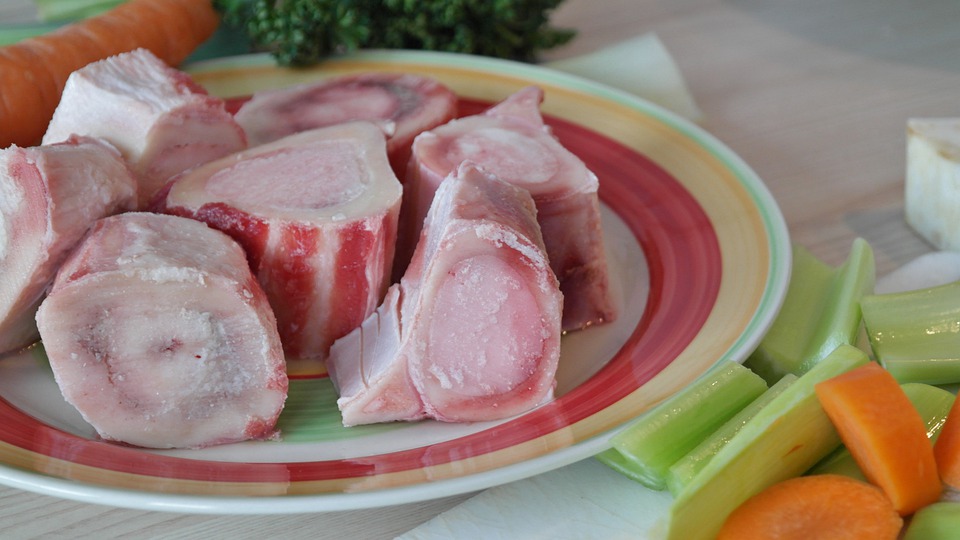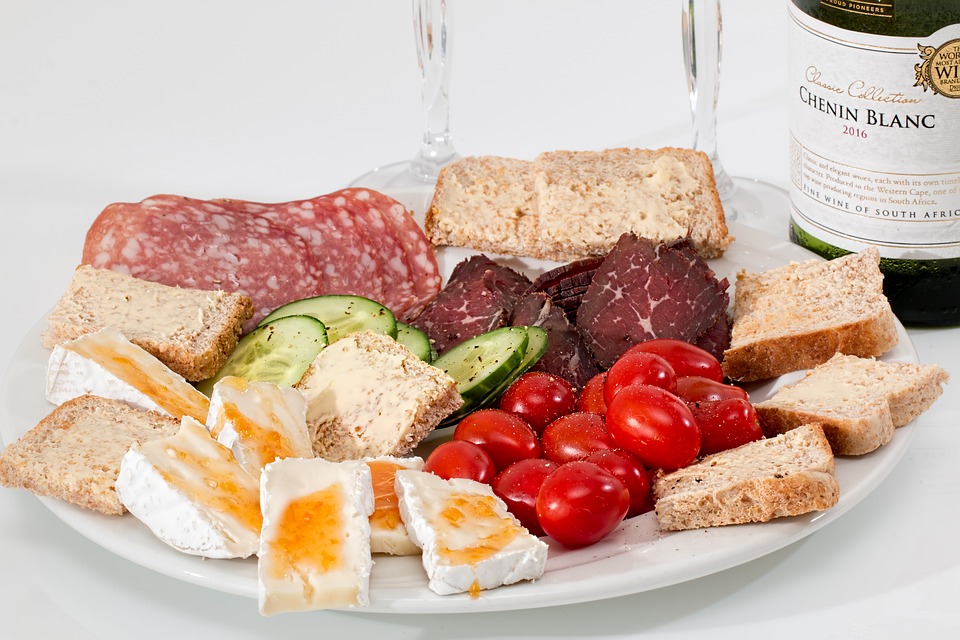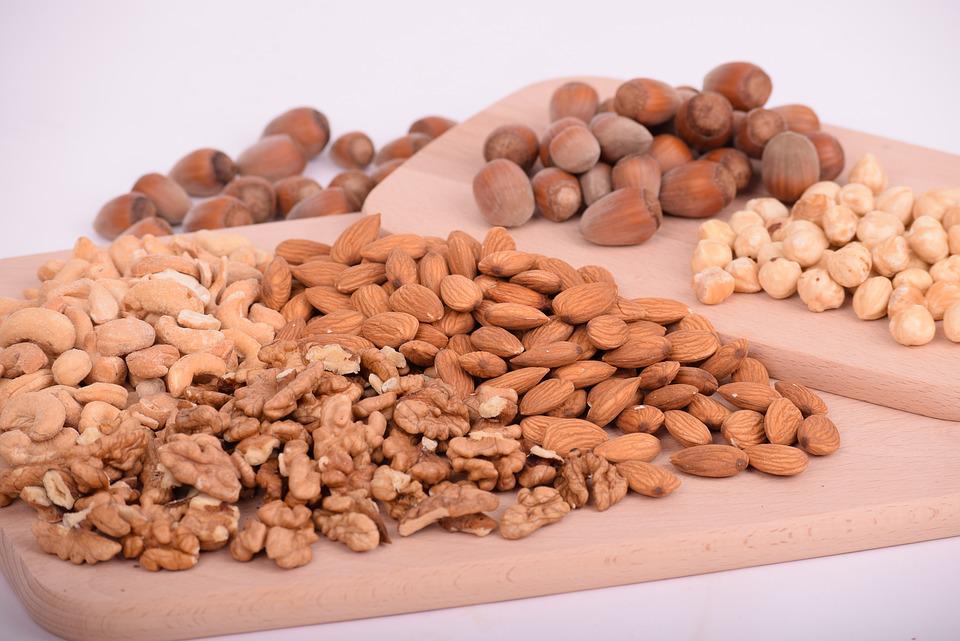
What is Bone Broth?
This type of broth is made specifically by cooking only bones. This results in a more intense flavor since there’s no meat or vegetables to dilute the taste.
SIMMER: Regular broths are simmered for anywhere between 45 minutes and two hours. Bone broths, on the other hand, take significantly longer to cook. The extra cooking time for bone broths is due to the fact that they require a longer time to extract all the nutrients from the bones.
Regular broths are high in protein, but bone broths have even more, along with minerals, collagen, glutamine, glycine, and proline.
We’ve covered the basics of bone broth, so now let’s discuss how it can improve your overall health.
Bone Broth Health Benefits
In this article, we will explore the many ways in which bone broth can promote health. From how it helps with fatigue and exhaustion to how it can ease the symptoms of IBS, leaky gut, and much more.
Joint Pain
Joint pain can be caused by injury, overuse, or chronic conditions such as osteoarthritis. Osteoarthritis is the most common type of arthritis and is considered one of the most significant health problems in the modern world. Unfortunately, one out of four persons will suffer from osteoarthritis at some point in their lifetime.
Although this condition is often thought of as affecting the elderly and inactive, younger, physically active adults and athletes may also be affected.
Although bone broth will not cure ailments such as osteoarthritis, it can potentially reduce joint pain, regardless of the source.
The reason for this is that bone broth is rich in amino acids such as methionine, which help in the maintenance and creation of cartilage tissue.
Metabolism Boost & Detox
Bone broth contains glutathione, vitamin C, and other antioxidants that play an important role in nutrient metabolism, immune responses, and antioxidant defense.
Each of the aforementioned factors can lead to increased detoxification and metabolism, both of which can help with weight loss.
A slow metabolism is often associated with obesity. Bone broth can help cleanse your body of toxins and regulate weight.
A successful weight loss plan is built around a diet that is rich in protein, with the bone broth being a great source of this macronutrient.
The amount of bone broth you consume will be different depending on what you want to achieve.
There is not much evidence-based research to support consuming large amounts of bone broth.
When making bone broth, it is important to be aware that contaminants from the bones may be extracted into the broth. This is more likely to happen with bones from non-organic sources, but there is no way to guarantee that bones from any source will be completely free of contaminants. This is something to keep in mind if you are planning to do an extreme cleanse that involves consuming large quantities of bone broth.
If you’re looking to boost your metabolism or detox your body, it’s best to drink bone broth plain for a few days.
No, you will not go hungry if you drink bone broth. In addition to making you feel full, bone broth also gives you more energy and reduces feelings of exhaustion.
Gut Health & Conditions
A strong, healthy gut plays a vital role in disease prevention and maintaining a robust immune system. The health of our gut plays a determining role in our overall wellness. Our health is at risk if we do not properly digest and absorb the nutrients we consume. A strong, healthy gut is essential for disease prevention and maintaining a robust immune system.
A healthy gut is made up of a strong gut lining and efficient waste elimination. The small junctions in the small intestine need to be tight so that toxins and larger food particles don’t enter the bloodstream. The large intestine needs to be nourished so that it can eliminate waste efficiently and without leaving any toxins in the body.
Gelatine, as well as amino acids like proline, cysteine, and glutamic acid which are found in bone broth, play a significant role in maintaining a well-balanced digestion and a healthy gut overall. However, their capacity does not stop there!
Glutathione and gelatine can also help ease gut inflammation. That said, another set of bone broth health benefits is related to easing symptoms of conditions like leaky gut, IBS, or even ulcers!
A medical professional such as a functional medicine-trained physician or a functionally trained dietitian is often recommended for consuming bone broth daily for overall digestive health maintenance.
Skin Conditions
Your skin’s appearance depends on how well your body absorbs nutrients.
A research study that looked at over 13,000 teenagers struggling with acne found that all of them are more likely to experience acid reflux, bad breath, bloating, and constipation. These are all immune responses to a fault in digestion.
Bone broth can help heal your gut and improve your skin health. It can prevent breakouts and help with other skin conditions.
Bone broth can help improve the appearance of your skin by promoting elasticity and plumpness. This can help to slow down the aging process, as it depends on collagen and glycosaminoglycans, which are both found in high quantities in bone broth.
Sure, there are many foods that contain nutrients that stimulate collagen synthesis in the body; however, bone broth is one of the few that actually contains collagen.
In conclusion, bone broth provides benefits for your skin including radiance, reduced scarring, and fewer red marks. These effects are due to the alkaline and trace minerals present in bone broth.
Immune System Function
A number of health conditions are actually our body’s response to inflammation. In other words, our body is trying to tell us something is wrong, and that usually has to do with our digestion.
The immune system responds to toxins or small food particles in the bloodstream as if they are antigens, triggering a strong response. The resulting antibodies also attack healthy tissue, similar to autoimmune attacks.
Amino acids, collagen, and gelatin found in bone broth can help heal the gut lining and prevent the release of toxins and food particles into the blood system.
Stock, Broth, and FAQs
- What is the difference between a stock and a broth?
According to cookery mecca Larousse Gastronomique, stock is the liquid obtained from either simply Mirepoix (carrot/onion/celery) and bouquet garnish (bay leaf/thyme/parsley) OR a soup made with those things and meat pieces. Some say the broth is the bone stock fine strained and fat separated, for utmost clarity of liquid, able to be served alone. Stock is labeled here and there into sauces, stews, and soups, and not as ‘refined’ looking/texture as a broth. Then, some say that broth is the meat/veg/herb flavored water simmered, but without the bones. Stock is then a broth made with bones also and not really with meat. It is then argued that ‘vegetable broth’ doesn’t exist as there are no bones… And so the arguments go on.I don’t love getting into arguments just for the sake of arguing. I think there are far more important things somebody could be doing with their time than arguing about something. For example, they could be making a batch of stock. Stock is without bones and broth is with, and depending on your gut health, you will either cook it briefly (2-3 hours) or longer to extract the most goodness from the bones.
- Do I have to use organic bones for broth?
I would say that this is a necessity, not something that can be negotiated. Bones store a lot of toxins in the body – heavy metals, residue from antibiotics… You not only want the animals to have had a good life while they were alive, which is also non-negotiable for me, but you also want them to be free from disease and pesticides from grains, genetically modified grains, excess vaccinations, and antibiotics. “Clean eating” means having a clean food system, and I encourage you to explore ethical, organic meat in general. The great thing about it is that if you learn how to cook it slowly, you can then buy secondary cuts. With stock, bones are the most economical way to benefit from organics, returning about a liter of nourishing, healing goodness for around $4.
- So how long do I need to cook it?
The amount of time you should boil bones to make broth depends on the type of broth and how sensitive you are to histamines. Histamine levels increase as cooking continues, so if you have any family members who are prone to skin reactions, hay fever, or feeling “wired,” it’s best to boil the bones for shorter periods of time, 1-2 hours. Broths made with lots of meat, vegetables, onions, and herbs will still have plenty of flavor and goodness from the bones.
Fish only needs to be cooked for 1-2 hours to extract the gelatin and mineral goodness. If it’s cooked for any longer, it turns bitter and the flavor is impacted.
Chicken needs to be cooked for 1-12 hours depending on the cooking method used.
You should cook beef, lamb, or pork for 2 to 24 hours, depending on whether you want a short cook or a long cook.
- So how long does it last in the fridge?
If there is a good layer of fat on top of the liquid, refrigerated for a couple of weeks.
If you don’t have a good layer of fat on top, it will only last 3-4 days. The best way to make it last is to keep a couple of jars in the fridge and the rest in the freezer.
- What should I freeze it in?
The best way to store liquids in the freezer is in glass jars, leaving an inch of space at the top. This allows for expansion of the liquid when frozen, without risking a cracked jar.
- How long can it be frozen?
3 months fish
6 months meat
- Can I use bones we’ve eaten from?
Would it be okay if I spent hours in a pot bubbling away? I really don’t think you need to worry about me eating the drumstick! USE IT ALL UP. While we’re at it, I keep all scraps from cutting a raw onion, carrot, celery, or ends of herb bunches in the freezer in a big pyrex, ready and waiting for the next broth batch. Waste NOTHING!
- Can I use raw bones?
Is it possible to fry the chicken carcasses before adding them to the water for the marrow bones? Yes, you can fry the chicken carcasses before adding them to the water. I personally pan-fry them for a couple of minutes if they’re raw, to get a little flavor on them before the simmering starts. A little coconut oil, butter, tallow or ghee is fine. For beef knuckles, I roast those first at high 220C / 450F temperature for 45mins before adding to the marrow bones.
- Can I do anything with the cooked veggies after the stock has been made?
You can use them in a mashed veggie dish over the next few days. They have a lot of nutrients from the broth, and it helps the dish last longer. It’s a great way to save money and create less waste.
- Do I throw out the fat?
Do not remove the fat from the stock, as it has multiple benefits. Fat from healthy animals is especially good for your brain and body. Books such as Nourishing Traditions and Primal Body Primal Mind provide ample research on the benefits of traditional diets for maintaining a healthy body.
- Do I have to use apple cider vinegar? Why is it added to some recipes and not others?
You don’t have to use apple cider vinegar to make bone broth, but it does help to draw minerals out from particularly thick bones. For pork, lamb, and beef (especially marrow), adding a couple of tablespoons to 1/4 cup of vinegar is a great idea. If you don’t have any apple cider vinegar, though, it’s still better to make bone broth than not to make it at all. The vinegar aids the process, but it’s not essential to the process itself.
- Which are the best bones to use?
While all bones provide amino acids and gelatin, some bones have more gelatin than others and will therefore be more beneficial. However, don’t worry if you’re not able to get hold of these bones – all bones will still provide some benefit.
Chicken – wings, necks, feet
Beef – Knuckles, marrow
Pork – Knuckles, trotters
Lamb – shanks, knuckles, neck
Whitefish that isn’t very oily is good for you, but you should try not to get fish that are too big. This is because they could have mercury or radiation build-up. I love to use 3-4 leftover baby snappers after they have been oven-roasted.














